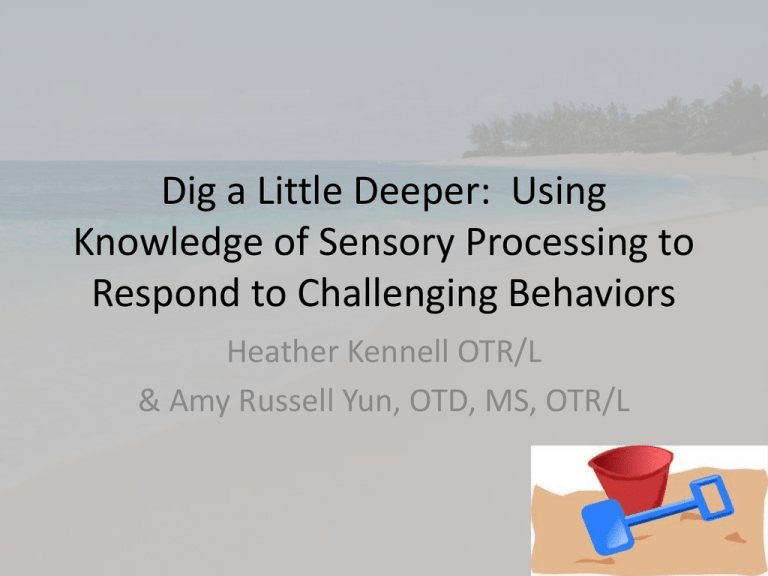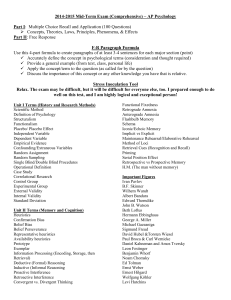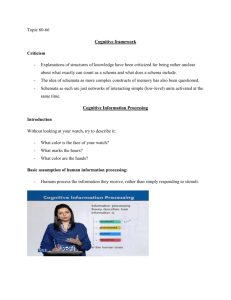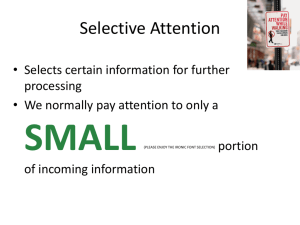Dig a Little Deeper: Using Knowledge of Sensory Processing to
advertisement

Dig a Little Deeper: Using Knowledge of Sensory Processing to Respond to Challenging Behaviors Heather Kennell OTR/L & Amy Russell Yun, OTD, MS, OTR/L “You can’t make children grow faster by pushing them, just as you can’t make flowers grow faster by pulling them” -Otto Weininger Sometimes “behavior” is just the tip of the iceberg Are we missing the remaining 90%? Behavior is a Form of Communication It may reflect many things • Poor quality of life • Little control in life • Illness/Pain • Few choices • Impairments in social skills or communication skills • STRESS Factors that Affect Behavior External Influences Internal Influences • Family transitions • Stress – Death of a family member/loss of a pet – Chronic or serious illness – Moving… • Unreasonable expectations – Heavy academic demands – Inappropriate educational placement • Abuse – Illness/injury – Unreasonable expectations • Cognitive functioning • Developmental profile • Communication difficulties • Temperament • Emotional problems • Learning difficulties Challenging Behavior • Is… – “Any repeated pattern of behavior, or perception of behavior, that interferes with or is at risk of interfering with optimal learning or engagement in pro-social interactions with peers & adults. Challenging behavior is thus defined on the basis of its effects." • Technical Assistance Center on Social Emotional Intervention for Young Children, (2009) Self-Regulation • Ability to regulate emotions & behavior • Ability to maintain physiological homeostasis • Who still needs to learn this? Domains of Selfregulation Behavioral selfregulation Ability to adjust one's activity (level) to contextual demands of environment. Cognitive selfregulation Ability to generate/maintain attention skills that meet needs of environment Emotional selfregulation Generating & maintaining suitable affect or emotional expression “appropriate” to demands of social environment Physiological self-regulation- Ability to maintain stable physiological processes (Als, Schore, 2001) Self Regulation Involves skills that develop over time • Cortex, particularly frontal & pre-frontal areas • Typically older children & adults have these skills Self-regulation skills can be developed &/or improved through interventions Designed to recognize & manage internal arousal states, thoughts, feelings, triggers… Mindfulness-Based Stress Reduction “How Does Your Engine Run?” (Shellenberger & Williams, 2007). Self Regulation Involves Psychobiological Factors • Body functions- anatomical & physiological interconnections amongst brain & body – External (the world) – Internal –thoughts, emotions, & perceptions • Biological – Cardiovascular & respiratory – Endocrine (e.g., hormones) • Psychological components – Cognitive – Emotional • Sensory – Pain, touch, visual, auditory, vestibular, olfactory, oral, proprioception • Biological Responses – Internal bio-physiology arise from body's interactions with the external environment If I go to Aspen (high altitude) Base elevation: 8,040 ft Summit elevation: 11,675 ft • Nervous system arousal, engagement, brain response, neurotransmitters & hormone response… – Allows person to adapt • Immediately – My cardiovascular system adapts to O² by heart rate • Long term – Experience changes in blood chemistry (↑hemoglobin to carry more O² ) Obtained from http://www.concierge.com/images/destination s/destinationguide/usa+canada/usa/colorado /aspen/aspen/aspen_006p.jpg Psychology Influences Biology • Cognition, perceptions, & emotions – May be instead of, or in addition to, environmental demands. – May/may not include “thinking”- does include reactions within body • Emotional reaction to smell of chocolate chip cookies – Relationships with others trigger emotional responses • Love is associated with hormone oxytocin in limbic system • Physical reactions - ↑ heart rate & facial flushing. – Perceptions influence responses • Actual experiences • Thinking about a task/activity… – Visualization Regulation of Body Systems & Behavior • Homeostasis “Rest” – Homeo, means "same,“ stasis means "stable;" – Remaining stable by staying the same • Allostasis “GO!!!” – – – – – Greek allo, means "variable;" stasis means stable “Remaining stable by being variable"[ Process of achieving stability thru physiological or behavioral change. Adaptive in the short term Proposed by Sterling & Eyre (1988) to describe process of reestablishing homeostasis in response to challenge • Allostatic load – Cumulative cost to the body of allostasis (McEwen & Wingfield, 2003) Co-regulation • Two branches of Autonomic Nervous System co-regulate each other (Kandel, Schwartz, & Jessell, 2000). – Sympathetic Branch (SNS)/Sympathetic-adrenomedullary system [SAM])-Allostasis – Parasympathetic branch (PNS) -homeostasis • They act opposite of each other & one system dominates the other at a particular time • Work together to fine tune responses to allow us to adapt & survive • Pretty much unconscious process through the ANS AUTONOMIC NERVOUS SYSTEM Each organ receives sympathetic & parasympathetic pathways!!! SYMPATHETIC thoracolumbar PARASYMPATHETIC Craniosacral Sympatheticadrenomedullary system [SAM] • Connections between – Sympathetic Nervous System – Adrenal medulla (adrenal gland) • Produces primary stress hormones – Epinephrine (adrenalin) – Norepinephrine (Noradrenalin) • Fast response (millisec) • Designed to be short-lived & highly responsive. • Drives the fear/flight or fight response-GO! – ↑ respiration, cardiac activity, & metabolic activity Hypothalamic-Pituitary-Adrenal (HPA) Axis • Releases – Cortisol, a corticosteroid – Raises blood sugar • Triggers release of stored fats • Breaks down stored proteins from tissue • Triggers liver to covert them into blood glucose. – Suppresses immune system – Puts homeostatic functions on hold • Digestion • Cell replenishment & repair. • Response – Within minutes of perceived stress – Sustained body mobilization Parasympathetic Nervous System • Concerned with generalized homeostasis – “Feed & Breed”– Primary goals revolve around conservation & restoration of energy • • • • Digestion & absorption of nutrients Body repair & healing Sexual reproduction Excretion of waste – Preserves the system Stress • Describes – Subjective experience induced by a novel, potentially threatening or distressing situation – Behavioral or neurochemical reactions to it • What is stressful for a baby? – Inability to regain homeostasis • State changes • Bodily needs-hunger, thirst… – Novelty • Transitions • Unpredictability Limbic System • • • • • • Important Motivation Emotion Memory Stress response Function – Emotion formation – Emotional behavior – Complex cognitive thought processing (memory) (Kandel, Schwartz, & Jessell, 2000) Emotions, learning & memory THE PAPEZ CIRCUIT CINGULATE CORTEX HIPPOCAMPUS FORNIX HYPOTHALAMUS ANTERIOR THALAMUS Emotions, learning & memory THE STRESS RESPONSE REGULATION OF THE “HPA” AXIS BY THE AMYGDALA AND HIPPOCAMPUS THE AMYGDALA STIMULATES THE “HPA” AXIS THE HIPPOCAMPUS INHIBITS THE “HPA” AXIS Stress Responses in the Brain • Mediated by CNS & ANS – Energy-expending SNS – Energy-conserving PNS } Regulate autonomic, somatic aspects of stress responses & emotional states. stress neurochemicals CNS ANS Limbic system (Seyle, 1956) Sympathetic– adrenomedullary (SAM) axis Processes emotions Low threshold for activation Appraises social info from facial (Malarkey, Lipkus, & Cacioppo, 1995) expressions w/o awareness (Critchley et Regulated by corticotropin al., 2000a) releasing factor -regulates Represents motivationally salient catecholamine release in SNS stimuli to adapt to environment (Brown, Fisher, Spiess, Rivier, Rivier & Vale. changes (Mesulam, 1998) 1982) Alters activity of neuro-modulatory Hypothalamo–pituitary– systems responsible for emotional adrenocortical (HPA) axis. states & arousal (Tucker, 1992). Regulated by cortisol (Yehuda, 1999). General Adaptation Syndrome • Stages of response – Alarm • Person identifies threat (stressor) – SAM & HPA (stress responses) activated – Resistance • If stressor persists, person needs to attempt to cope body tries to adapt to demands of environment, • Cannot keep up indefinitely & resources are depleted – Exhaustion • Body's resources are depleted • Unable to maintain normal function. – If person spends extended time in this stage, long term damage results (Selye, 1950 ) Yerkes-Dodson Principle Self Regulation Involves Skills • Relates to capacity to tolerate sensations of distress that accompany unmet needs – When an infant initially feels an unmet need such as hunger, s/he feels discomfort & distress & cries – Attuned caregiver responds & this cycle gets repeated multiple times. – Infant learns that feelings of discomfort & distress, will pass – Later child learns to interpret & respond to inner cues – Child becomes able to tolerate discomfort & distress – Child can tolerate a certain level of anxiety & becomes less reactive & impulsive. – This enables child to feel more comfortable & behave in a more "mature" manner when faced with physical, emotional, social, & cognitive challenges Ayres Hypothesized Integration Neuro Early Brain Development Concepts • Brains are built over time, from the bottom up Early Brain Development Concepts • The brain is shaped by the influence of genes, the influence of experience, and their interactions Early Brain Development Concepts • Although the brain is continually changing and adapting, its capacity for change decreases with age Early Brain Development Concepts • Cognitive, emotional, and social abilities are intertwined throughout the life span Early Brain Development Concepts • Toxic stress damages developing brains, which can lead to chronic problems in learning, behavior, and physical and mental health Radley et al. (2004), BOCK ET AL. (2005) Early Brain Development Concepts • Early experiences can have both cumulative and delayed effects on development What is Sensory Integration? • “Sensory integration is the process of organizing sensory inputs so that the brain produces a useful body response and also useful perceptions, emotions, and thoughts.” • -Ayers, 1979, p. 28 In a sensory processing model, our approach changes: • Instead of a ‘top down’ approach where where we address the visible behavior, In a sensory processing model, our approach changes: • We adopt a ‘bottom-up” approach where we look closely at the underlying neurological factors that influence those visible behaviors we see Liam’s got the right idea! Moving Beyond the 7 Senses… Vision • Functions: • What is vision? ©2010 Lil’ Munchkins What is involved in vision? • Ability to register visual info • Ability to attend to visual info • Ability to move eyes in a coordinated fashion • Ability to discriminate amongst different stimuli • Ability to perceive movement • Ability to move eyes with head VISION Eyes • Photoreceptors • Convert light into neural activity Visual Pathway • Optic nerve brings information to occipital lobe of brain where it is processed VISUAL SYSTEM PRIMARY VISUAL CORTEX (V1) 3° (area 17; occipital cortex) optic radiations LATERAL GENICULATE NUCLEUS 2° (LGN; visual thalamus) optic tract optic chiasm optic nerve (CN II) RETINAL GANGLION CELLS 1° VISUAL SYSTEM PATHWAYS IMPORTANT FOR GENERATING EYE MOVEMENTS SUPERIOR COLLICULUS superficial layers: visual • superficial layers: integrates multisensory information • generating spatially directed head turns • arm-reaching movements • shifts in attention not involving movements Vision Affects Behavior… Child might.. Avoid or daydream during activities requiring close visual attention Be clumsy Have difficulty judging distances …targets/catching Tilt head or assume atypical postures or positions Make odd facial expressions during work at different distances (esp. close) Experience - nausea, dizziness, fatigue, head aches Caregivers might report • Inattention • Clumsiness • Avoidance • “Behavioral problems” • “Poor work skills” or habits • Low frustration tolerance Visual Attention Awareness & Attention to Objects – Hold interesting object close to child (arms reach or less) – Move object (activate it or talk about it) – Observe child's response to see if it was noticed. – Practice until visual fixation is maintained. • • • • ↑ length of visual fixation ↑ distance Work to develop reach (2 handed, then 1 handed) ↓contrast between object & environment Visual Form Recognition Auditory • Location: inner ear • Function: provides information about sounds in the environment • What is involved? ©2010 Lil’ Munchkins AUDITORY SYSTEM AUDITORY SYSTEM SOUND WAVE ENERGY MECHANICAL ENERGY FLUID WAVE ENERGY AP (audible variation in air pressure) CN VIII AUDITORY SYSTEM Auditory cortex Medial geniculate Ascends to brainDescends to the body Chemoreceptors • Gustatory • Location: chemical receptors in the tongue • Function: provides information about different types of taste • Olfaction • Location: chemical receptors in the nasal structure • Function: provides information about different types of smell ©2010 Lil’ Munchkins Somatosensory Systems Tactile Proprioceptive Function: provides information about the environment, objects & their properties Function: provides information about where a certain body part is how it is moving • changes in angle & position • calibration of force • tension in specific parts of muscle What is this information? ©2010 Lil’ Munchkins ©2010 Lil’ Munchkins SOMATOSENSORY Senses Pain (sharp & localized, or diffuse & deep); Nociceptors Temperature (sharp & localized, or diffuse & deep); Thermoreceptors - can be noxious at extremes (<5°C and >45 °C) Discriminative touch Vibratory sense Proprioception FIRST AND SECOND PAIN SOMATOTOPIC MAP NOT ALL SENSATION IS EQUAL • Note the relative size of the cortex devoted to different body parts • This correlates to the density of sensory input from that area • Reflects the importance of that part HOMUNCULUS Somatosensory Input • Comes from different receptors Where does proprioception come from? DESCENDING PAIN-MODULATORY PATHWAYS Thankfully, tracts from a number of brain regions INHIBIT dorsal horn cells from conveying nociceptive (PAIN) information to higher brain centers MODULATORY FUNCTION• Tell us what to attend to & what to ignore Vestibular • Location: inner ear • Function: provides information about where our body is in space ©2010 Lil’ Munchkins VESTIBULAR SYSTEM 1 OTOLITH ORGANS (UTRICLE & SACCULE): detect forces of gravity & linear acceleration of head 2 SEMICIRCULAR CANALS: sensitive to head rotation- angular acceleration VESTIBULAR SYSTEM 1° VESTIBULAR GANGLIA (SCARPA’S) 2° VESTIBULAR NUCLEI CN VIII 3° VPL 4° VESTIBULAR CORTEX (THALAMUS) ON POSTCENTRAL GYRUS NEAR FACE REPRESENTATION • Tectospinal tract • Coordinates eye & head movements • Mediate postural reflexes in relation to visual & auditory input • Vestibulospinal tract • Alter muscle tone • Extend limb & head position • Alter posture VESTIBULAR SYSTEM VESTIBULO-OCULAR REFLEX (VOR) Allows eyes to move automatically to compensate for head movement This allows you to keep your eyes fixed on a stable target MOTOR: HIGHER CENTERS MOTOR CONTROL HIERARCHY Ideation: a movement plan that best achieves a goal Motor Planning: the sequences of muscle contractions, arranged in time & space, required to smoothly & accurately achieve the strategic goal EXECUTION: activation of the motor neuron and interneuron pools that generate the goaldirected movement & make any necessary adjustments of posture Working Together Let’s consider how sensory information contributes to development * Activity Observations reflecting increased or decreased levels of arousal in young children • Autonomic • • • • Yawning & sneezing Hiccuping Sweating Changes in skin color – Flushing – Palor – Mottling • • • • Spitting up/gagging Breathing changes Rapid state changes Losing bowel/bladder control • Behavioral – – – – – – Fussiness Crying Startling Becoming stiff Sighing Extension/ arching back/splaying of fingers & toes – Averting gaze Spitzer & Smith Roley, (2002). Sensory Thresholds & Behavioral Responses (Winnie Dunn) Neurological Thresholds Behavior Responses In accordance w/threshold To counteract Threshold Poor registration Sensation Seeking Sensitivity to Stimuli Sensation Avoiding High (habituation) Low (sensitization) “There is no such thing as a baby, there is a baby & someone…” (Winnacott, 1987) Emotions, Learning & Memory LEARNING change in response over time to a single stimulus forming associations between events Tips for Enhancing Self Regulation • Work on YOUR OWN capacity for self-regulation • Be attuned to child & child’s needs – ANS signs –check to ensure accurate behavior interpretation • Start with proximal strategies for regulation & move to distal ones • Provide structure & predictability (helps child develop internal “structure." – Too flexible -likely to see uncontrolled behaviors to seek structure. • Anticipate transitions & prepare child for them in advance – Timers-one more minute-songs… Strategies for Teaching • • Get caregivers to regulate selves!!! Focus!!! – • Motivation matters! – – • Target specific areas for growth & specific strategies to address them Use materials & activities of interest Work to broaden interests Keep it light! – – Be positive & have FUN Encourage flexibility. • Context – • Start with what is needed & desired (social routines) Practice – – • Reinforce learning Generalize to different people, settings, & materials Structure & routine add predictability & comfort – Visual environment is important • • – Placement of objects Visual schedule Social scripts can be a building block Coping • “Things people do to avoid being harmed by life strain” (Pearlin & Schooler, • Problem focused coping – Attempts to • Deal with reality & consequences of crisis • Create a better situation 1982, p. 109) • Patterns of coping responses – Change the stressful experience – Control the meaning – Manage stress • Appraisal-focused coping – Efforts to understand & find meaning in a crisis • Emotion-focused coping – Handling feelings provoked by the crisis • Moos & Billings (1982) Attacking the Problem • Change situations -that cause stressful experiences – To do this • Situation must be amenable to change • Person must 1. Recognize the situation which is causing stress – Difficult to do 2. Know to change the situation directly – Often changing one situation leads to different additional stressors • Making careful observations of the sensory environment can help avoid un-needed stressful situations Think about the Sensory Contributions to the Environment • What type of sensory information is present? – – – – – – – Visually Auditory Vestibular Proprioceptive Tactile Olfactory Gustatory • Consider the following for each – Intensity-strength or power – Duration – of the stimulation – Location – Predictability Emotion, learning & memory NONASSOCIATIVE LEARNING HABITUATION: repeated presentation of the same stimulus produces a progressively smaller response SENSITIZATION: a strong stimulus results in an exaggerated response to all subsequent stimuli • Calming – Predictability – Rhythm – Neutrality –middle • Alerting – Irregularity – Novelty – Intensity • Extremes Managing the Stress • Control stress after it emerges (Pearlin & Schooler, 1982, p. 115) • Focus on managing stress resulting from stressors Attunement Mutual Eye Contact Baby smiles Mother respondsusually by smiling Right Brain Attunement Joint Attention – Process of sharing one’s experience of observing an object or event, by following gaze or pointing gestures. – Critical for social development, language acquisition, cognitive development – Pre-linguistic communication skills that are used to initiate or maintain turn-taking routines & used to request or obtain help in obtaining objects or events. – Joint attention is used to direct attention in order to share the experience of an object or event with another person Strategies to Build Joint Attention • Observe child – Watch for alternating his/her eye gaze between an object & person. • Playfully try to get child to make eye contact – Go to child’s level to make gaze shifts from object to face easier – Play with toys that draw the child’s attention to your face. (bubbles, pinwheels, balloons) – Hold onto objects you are giving child until he looks at you & bring it to eye level. • Follow child imitate his actions with an identical toy/object • Play with toys – Draw attention to adult’s actions. (that make noise /need to be activated, musical toys) – Facilitate reciprocal interaction (balls, blocks in a form box, a train, puppets, telephone) – Facilitate requests for help (a jar that is too hard to open, an favorite object out of reach, wind-up toys that are too hard to turn) Evidence for SMD is Growing Davies & Gavin (2007) Ability to habituate typically develops over time Children identified as having SMD demonstrate difficulties habituating to neurological stimuli compared with controls Difficulties increase with time & exposure to stimuli Schaaf, Miller, Seawall, & O’Keefe (2003) Children with SMD demonstrate vagal tone (PNS) Children with SMD do not habituate to repeated stimuli Do not shut off SNS McIntosh, Miller, Shyu, & Hagerman, (1999). Electrodermal responses high amplitude orienting is associated with poorer performance on the SSP Early Brain Development Concepts • Children learn best through hands-on experiences which require problem solving








